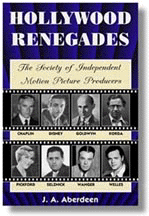 SIMPP FAQ
(Frequently Asked Questions) SIMPP FAQ
(Frequently Asked Questions)
What Is SIMPP?
SIMPP stands for the Society of Independent Motion Picture Producers
an organization that was formed by Charlie Chaplin, Walt Disney, Samuel
Goldwyn, Alexander Korda, Mary Pickford, David O. Selznick, Walter Wanger,
and Orson Welles. The group evolved into one of the most important trade
organizations in classic Hollywood, with members that included many high-profile independent filmmakers and industry talent.
When was SIMPP formed?
The Society was formed in 1941, but the producers kept the organization a secret
until 1942.
Why was SIMPP formed?
SIMPP was formed by filmmakers who opposed movie monopolization. They wanted
to curtail the growing power of the major Hollywood movie studios
(Paramount, MGM, Warner Bros., Twentieth Century-Fox, and RKO), which not
only owned the largest film factories in the world, but also controlled the
largest theater chains in all parts of the United States. SIMPP assisted the
government in its antitrust case against the major studios until it became
illegal for the film studios to own movie theater chains.
Did SIMPP include producers only?
No. Members included not only producers, but also producer-directors, and
even actors who achieved a degree of autonomy from the studio system. SIMPP
admitted individuals or companies that operated independent or
semi-independent from the majors.
Who were some of the other prominent members of SIMPP?
Howard Hughes, Preston Sturges, James Cagney, Bing Crosby, Constance Bennett, John Huston, San
Spiegel, Stanley Kramer, Hunt
Stromberg, Sol Lesser, and Hal Roach.
If SIMPP's members were some of the biggest names in Hollywood, what made
them "independent"?
These producers considered themselves independent because they made their
own movies (i.e., financed their films, selected story material, hired
talent) outside of the studio system. They were not on the studio payroll;
they made their films without studio interference; then they would use the major
studios as a distributor for their pictures. Early on in SIMPP, an independent
producer was defined as someone who produced movies, but did not distribute
them. Later the distinction became ambiguous as many of the prominent indies
like Walt Disney and David O. Selznick moved into distribution.
Of course, I have heard of the individual members of the Societybut I have never heard
of SIMPP before. Was SIMPP an obscure organization?
No. Based on the trade listings of the time, SIMPP became one of the largest
and most influential groups in Hollywood. During the 1940s, SIMPP was the
only significant trade organization to challenge the Motion Picture
Association of America (MPAA), the trade organization of the major studios.
SIMPP had a voice in the most important industry matters from the antitrust
case, to censorship, to the blacklist. SIMPP commanded headlines and made
national news on a regular basis.
How come I have never heard of SIMPP?
The Society was divided by disagreements among its members in the late
1950s. Lacking unity and direction after the successful antitrust case,
SIMPP disbanded in the early 1960s when it was taken over by the Disney
Studio. Why the Society has been overlooked by film historians, is one of
the mysteries that is answered by the book Hollywood Renegades: The Society
of Independent Motion Picture Producers.
What is Hollywood Renegades?
Hollywood Renegades is the title of the first full-length account of the
Society of Independent Motion Picture Producers. Film historian J. A.
Aberdeen chronicles the history of SIMPP, and uses never-before-published
records to reveal new facts regarding the SIMPP members such as Walt Disney,
Samuel Goldwyn, and Orson Welles.
|

